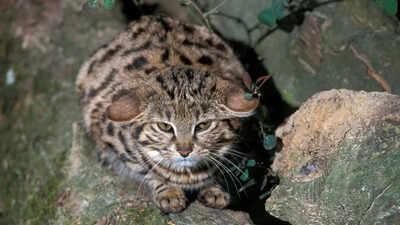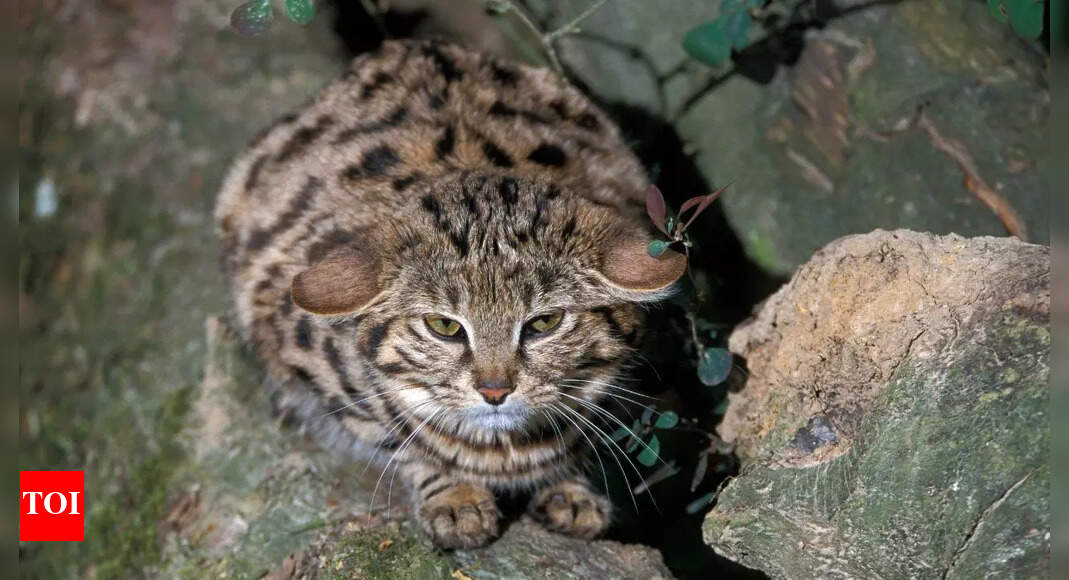 Among the dry grasslands and sandy deserts of southern Africa lives one of nature’s smallest yet most determined hunters, the Black-footed cat (Felis nigripes). Weighing no more than a bag of sugar and standing barely 20 centimetres tall, this fierce little feline is Africa’s tiniest wild cat, but its spirit is anything but small. Despite its delicate appearance, the Black-footed cat is a tenacious predator capable of taking down prey nearly its own size. Research supported by The International Society for Endangered Cats (ISEC) Canada has revealed fascinating insights into this elusive species, from its fearless attitude to its dwindling population and the growing need for conservation.
Among the dry grasslands and sandy deserts of southern Africa lives one of nature’s smallest yet most determined hunters, the Black-footed cat (Felis nigripes). Weighing no more than a bag of sugar and standing barely 20 centimetres tall, this fierce little feline is Africa’s tiniest wild cat, but its spirit is anything but small. Despite its delicate appearance, the Black-footed cat is a tenacious predator capable of taking down prey nearly its own size. Research supported by The International Society for Endangered Cats (ISEC) Canada has revealed fascinating insights into this elusive species, from its fearless attitude to its dwindling population and the growing need for conservation.
Unique traits of the Black-footed cat
The Black-footed cat is among the smallest wild cat species in the world, measuring just 36–52 cm in body length and weighing between 1–2.5 kg. Yet, its compact body hides an impressive set of adaptations that make it one of the most efficient predators in its ecosystem.
- Distinctive appearance: Its soft, dense fur ranges from pale tawny gold to darker brown, marked with bold black or brown spots and bands. Its white underbelly contrasts with the black soles of its feet, which give the species its name.
- Adaptations to the desert: These cats are perfectly built for their harsh environment. Their broad skulls and large rounded ears enhance hearing, vital for detecting small prey in open terrain. The fur-covered soles protect them from scorching desert sand.
- Unique behavioural traits: Despite their size, they exhibit remarkable bravery. Local legends even claim that a Black-footed cat can bring down a giraffe — an exaggeration that reflects their fierce reputation among local people.
- Found only in Botswana, Namibia, and South Africa, they prefer open grasslands and scrub deserts like the Kalahari and Karoo regions. Their survival depends on these arid habitats, where their camouflage helps them blend seamlessly into the environment.
Hunting habits and diet of the Black-footed cat
Nicknamed the “anthill tiger” for their habit of resting in abandoned termite mounds, Black-footed cats are nocturnal creatures with an incredible appetite for hunting. Despite their small frame, their stamina and precision make them one of Africa’s most efficient predators.Relentless hunters: A single cat can kill up to 3,000 rodents per year, playing a vital role in maintaining ecological balance.
- Diet diversity: Around 72% of their diet consists of small mammals, with birds and insects making up the rest. They have been observed preying on mice, small birds, and even adult Cape hares, which can weigh nearly as much as the cats themselves.
- Unique hunting tactics: Their strategy includes waiting patiently near rodent burrows for up to 40 minutes, or moving swiftly through grass to flush out nesting birds. They can leap up to 2 metres in distance and 1.5 metres high when hunting flying prey.
- Adaptability: Black-footed cats can get their water intake from their prey but will drink if water is available. During the day, they retreat into burrows to escape predators like jackals and birds of prey.
- Their fierce independence is often noted by researchers who have observed them standing their ground against larger carnivores. In one documented case, a tiny Black-footed cat successfully scared off a circling black-backed jackal — a testament to its fearless nature.
Life cycle of the Black-footed cat: Mating, motherhood, and survival
Black-footed cats are solitary by nature, coming together only during mating season. Their reproductive habits are finely tuned to survive the demanding desert environment.
- Breeding pattern: After a gestation period of about 63–68 days, females give birth to one to four kittens in underground burrows or termite mounds.
- Parental care: Mothers are extremely cautious, frequently shifting their dens to protect their young from predators.
- Growth milestones: Kittens open their eyes after a week and start hunting at just a few months old. They become independent at 3–4 months but often stay within their mother’s territory for longer.
- Survival instincts: When danger approaches, mothers signal their kittens to scatter and freeze — a behaviour that increases their chances of survival in open terrain.
These behaviours highlight the cat’s remarkable ability to adapt and thrive, even in regions with scarce prey and extreme temperatures.
Protecting Africa’s tiny wild cat from extinction
Despite their resilience, Black-footed cats face numerous threats that are pushing their population into decline. The species is currently classified as Vulnerable, with numbers decreasing across their range.
- Habitat loss and prey decline: Overgrazing by livestock reduces grass cover, diminishing populations of small rodents and birds — the cat’s main food sources.
- Poisoning risks: Farmers often use poisoned carcasses to control larger predators like jackals and caracals. Unfortunately, the small cats, being scavengers, also consume these carcasses and die from secondary poisoning.
- Pesticides and locust control: Widespread pesticide use to eliminate locusts has an unintended impact, as these insects form part of the cat’s diet.
- Human conflict: Domestic dogs used in predator control sometimes attack or kill Black-footed cats.
Conservationists recommend more focused field research in Namibia and Botswana to better understand their distribution and behaviour. Captive breeding programmes, such as those in Germany’s Wuppertal Zoo, have shown promising success and may help preserve the species in the long term.Despite their challenges, these desert survivors continue to captivate researchers and wildlife enthusiasts worldwide. Their courage, adaptability and fierce independence serve as reminders that even the smallest creatures can have the heart of a lion.Also Read | Asian Golden Cat: Asia’s most mysterious and fearless feline that can take down prey twice its size
